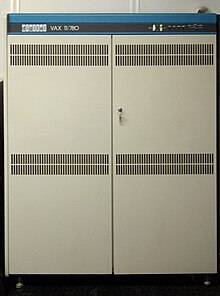Mini computer
Minirechner (partly translated from English minicomputer loan ) or small computer is a name for a class of computers . The term originated in the late 1960s when the first "small" computers were being built. “Small” in this context meant that the computer no longer filled entire halls, but only consisted of one or more cupboards. Some mini computers were so small that they could be placed on a stable desk. The models of this computer class designed for commercial applications formed the middle data technology .
General

In contrast to the later personal computers ( PCs ), all these systems were multi-user systems , also in terms of their operating systems. Several programmers and operators could work simultaneously on one of these computers .
In contemporary parlance, there was an even finer distinction between “mini computers” (only one, possibly large, cabinet) and “midi computers” (several cabinets).
From a technical point of view, minicomputers belong to the second and third generation of computers.
The American company Digital Equipment Corporation (DEC) developed the PDP-1 in the 1960s in order to create a smaller and less expensive variant of the mainframe computers . This first mini-computer was about the size of a closet. On March 22, 1965, the much smaller PDP-8 was presented in New York . It cost around $ 16,000 and ran at 1 megahertz. The first PDP-8 series was built entirely with discrete semiconductor technology (second generation). From 1970 the PDP-11 family joined them. The first PDP-11 was already based on integrated circuits . Both computer families have been expanded several times and implemented in newer technologies. PDP-8 and PDP-11 microprocessors exist. Therefore it can be said that the last models of PDPs were no longer real mini-computers. The PDP series was mainly used in universities, as well as larger companies and authorities, which finally saw the opportunity to integrate computer technology into research, teaching and other activities.
In addition, between 1968 and 1978, the Aachen-based electronics company Krantz Computer manufactured minicomputers from the Mulby and Indata series , most recently in association with Varian Data Machines , a division of Varian Associates . They were used in the graphics industry , in traffic technology , production data acquisition , building technology and process control . Together with the Swiss telecommunications equipment manufacturer Autophon , information display systems were developed for the Mulby computers, which were used at airports, including Frankfurt Airport from 1977 , as well as at train stations and stock markets.
In the 1980s, minicomputers were replaced by fourth generation machines based on 32-bit microprocessor technology, which led to considerable losses for the respective manufacturers. It was not believed that home users would make extensive use of personal computers . But things turned out differently, and DEC and IBM in particular slept through this development, whereupon drops in profits of up to several billion dollars were not uncommon.
The market had to be restructured until the beginning of the 1990s. Many companies such as Philips , Nixdorf , Data General and Wang reoriented themselves or disappeared completely.
Selection of mini computers
- DEC PDP
- Prime Computer
- Data General Nova
- IBM AS / 400 and iSeries
- Nixdorf 820
- HP 3000 Series
- Norsk Data NORD-1 , NORD-10 and NORD-100
- Honeywell series 16
See also
Web links
Individual evidence
- ↑ From Textils to Computers Company History to Computer History Museum
- ^ Krantz computer archive
- ↑ Use of Krantz computers at the Computer History Museum